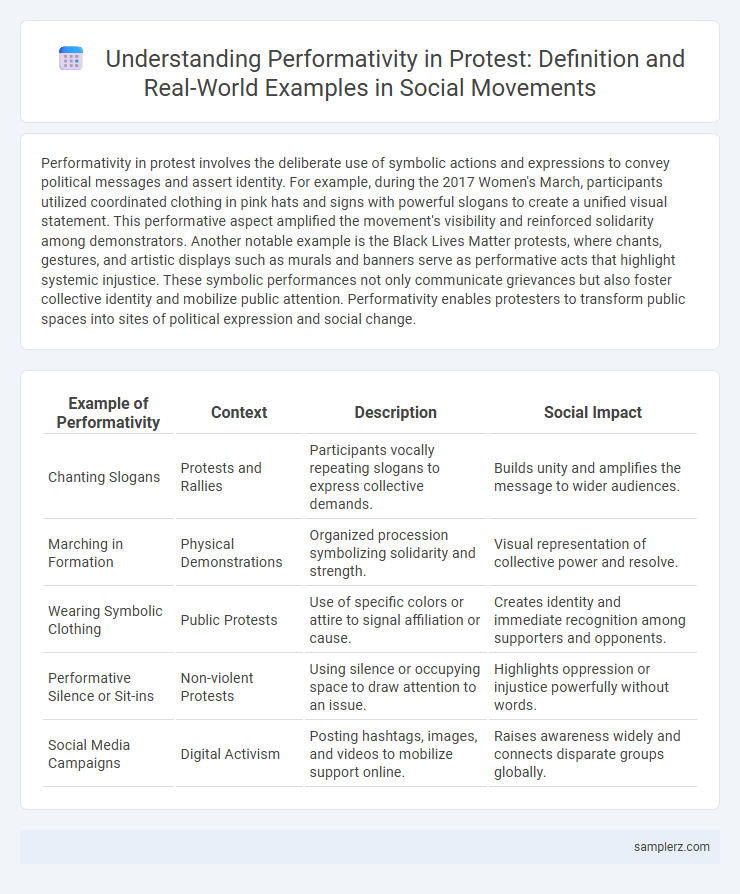Performativity in protest involves the deliberate use of symbolic actions and expressions to convey political messages and assert identity. For example, during the 2017 Women's March, participants utilized coordinated clothing in pink hats and signs with powerful slogans to create a unified visual statement. This performative aspect amplified the movement's visibility and reinforced solidarity among demonstrators. Another notable example is the Black Lives Matter protests, where chants, gestures, and artistic displays such as murals and banners serve as performative acts that highlight systemic injustice. These symbolic performances not only communicate grievances but also foster collective identity and mobilize public attention. Performativity enables protesters to transform public spaces into sites of political expression and social change.
Table of Comparison
| Example of Performativity | Context | Description | Social Impact |
|---|---|---|---|
| Chanting Slogans | Protests and Rallies | Participants vocally repeating slogans to express collective demands. | Builds unity and amplifies the message to wider audiences. |
| Marching in Formation | Physical Demonstrations | Organized procession symbolizing solidarity and strength. | Visual representation of collective power and resolve. |
| Wearing Symbolic Clothing | Public Protests | Use of specific colors or attire to signal affiliation or cause. | Creates identity and immediate recognition among supporters and opponents. |
| Performative Silence or Sit-ins | Non-violent Protests | Using silence or occupying space to draw attention to an issue. | Highlights oppression or injustice powerfully without words. |
| Social Media Campaigns | Digital Activism | Posting hashtags, images, and videos to mobilize support online. | Raises awareness widely and connects disparate groups globally. |
Exploring Performativity in Contemporary Social Protests
Contemporary social protests exemplify performativity through symbolic gestures, collective chants, and choreographed movements that communicate political demands beyond verbal rhetoric. These performative acts generate shared emotional resonance and visibility, transforming public spaces into stages for social resistance and identity assertion. The embodied expressions in protests function as powerful semiotic tools shaping public discourse and influencing policy debates.
The Role of Chants and Slogans as Performative Acts
Chants and slogans function as performative acts in protests by constituting collective identity and transforming participants into active agents of social change. Through repetition and vocalization, these utterances enact demands and solidify solidarity, reinforcing the movement's legitimacy and urgency. This performativity transcends mere expression, creating a reality where protestors' voices manifest political will and resistance.
Performance Art in Street Demonstrations
Performance art in street demonstrations transforms public spaces into dynamic stages, using body movement, visual symbolism, and interactive elements to convey powerful political messages. Activists employ rituals, costumes, and choreographed actions to engage bystanders, blur the lines between art and activism, and provoke social change. These performative protests amplify marginalized voices and create immersive experiences that challenge dominant narratives and inspire public discourse.
Symbolic Gestures: Kneeling and Raised Fists in Protest
Kneeling during protests symbolizes humility and resistance, originating from Colin Kaepernick's 2016 NFL protest against racial injustice. Raised fists trace back to the Black Power movement, embodying solidarity and strength in the struggle against oppression. These symbolic gestures performatively communicate dissent and unite participants across diverse social movements.
Costumes and Body Paint: Visual Performativity in Activism
Costumes and body paint serve as powerful tools of visual performativity in activism, transforming protest spaces into vivid displays of identity and resistance. These visual elements communicate political messages nonverbally, amplifying collective voices through symbolic imagery and cultural references. The strategic use of color, patterns, and iconography in costumes and body paint heightens emotional impact and fosters solidarity among protesters.
Social Media Hashtags as Performative Protest Tools
Social media hashtags act as powerful performative protest tools by amplifying collective voices and creating digital spaces for activism, such as #BlackLivesMatter and #MeToo. These hashtags not only signal solidarity but also mobilize participants, influence public opinion, and pressure policymakers through widespread visibility. The performativity of hashtag activism lies in its ability to transform online expressions into real-world social and political impact.
Flash Mobs: Coordinated Expression in Social Movements
Flash mobs exemplify performativity in protest by transforming collective action into spontaneous, visually striking demonstrations that disrupt everyday routines and capture public attention. These coordinated performances leverage choreography and timing to communicate political messages, amplifying social movements' visibility and emotional impact. By embedding protest within artistic expression, flash mobs create powerful, temporary spaces for collective dissent that challenge conventional modes of activism.
Theatrical Reenactments in Historical Protests
Theatrical reenactments in historical protests serve as powerful performative acts that embody collective memory and amplify political messages. By recreating iconic moments from past struggles, protesters transform public spaces into immersive stages, enabling spectators to viscerally experience the symbolism and emotional intensity of resistance movements. These performative protests harness dramatization to mobilize support, reinforce group identity, and vividly communicate demands for social or political change.
Public Die-Ins: Embodying Performativity for Change
Public die-ins exemplify performativity in protest by transforming bodies into symbols of social issues, vividly illustrating the urgency of systemic change. Participants lie motionless in public spaces, embodying the vulnerability and loss caused by injustices such as police violence or environmental crises. This embodied performance disrupts everyday routines, compelling onlookers to confront the realities behind the cause and sparking collective empathy and activism.
Performativity in Silent Marches and Vigils
Silent marches and vigils embody performativity through nonverbal, embodied expressions of dissent that communicate solidarity and resistance. Participants use body language, symbolic silence, and spatial arrangement to convey powerful political and social messages without spoken words. These forms of protest harness performative acts to create a shared sense of identity and amplify marginalized voices in public spaces.

example of performativity in protest Infographic
 samplerz.com
samplerz.com